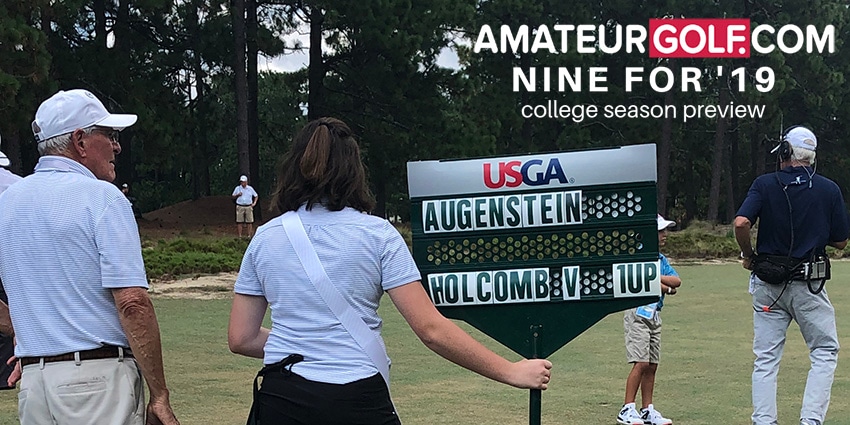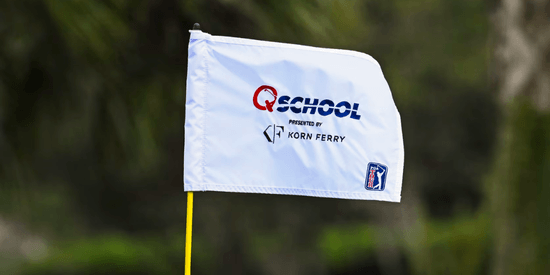Nine for '19, No. 3: In college golf, match play matters
9/9/2019 | by Julie Williams of AmateurGolf.com

A player who understands the nuances of match play, and how to play it, is an asset to any college team.
With a new college golf season approaching, we present our “Nine for ‘19” series. In the countdown to the first major weekend of college competition, we take a look at the nine best storylines for the fall. Consider this your primer for one of our favorite parts of the game.
The list of match-play upsets from the past four months is long and distinguished. Erica Shepherd’s name stands out not particularly for the loss itself in the first round of the U.S. Girls’ Junior, but for the soundbite that followed. Shepherd, who won the event in 2017 and now is a Duke freshman, was a No. 9 seed that went down at the hands of No. 56-seeded Kelly Xu.
This innocent dagger from Xu came later: “I had to learn about match play by Googling it last night. I definitely like playing it more than stroke play.”
When amateur golf gets a television slot – as it has a handful of times over the summer season – audiences are usually watching match play. There’s good reason for that: Match play just translates better, particularly where team golf (i.e., college golf) is concerned.
Rankings, seeds and resumes go out the window in match play (see above). Grumbling often follows. In last month’s U.S. Amateur at Pinehurst (N.C.) Resort, only two of the eight quarterfinalists were inside the top 100 in the World Amateur Golf Ranking. Two more were outside the top 300 and one (17-year-old Cohen Trolio) wasn’t ranked at all.
At No. 38, eventual runner-up John Augenstein, a Vanderbilt senior, carried the best ranking.
“I think that what's understated in a lot of match play is that you don't have to go out there and shoot 6-, 7-, 8-under to beat somebody,” said Augenstein, who on Sunday clinched the winning point for the U.S. Walker Cup team. “All you have to do is hit necessary golf shots. If he hits it to 20 feet, try to hit it to 15. If he hits it to eight feet, try to hit it to seven.”
There are fundamental differences between match play and stroke play, namely in strategy and how the field comes into play. Essentially, it’s a difference between a head-to-head battle and protecting the field. The better-ranked or better-seeded team has an excellent chance of losing, and often does.
There’s no better example of that than Oklahoma State’s early out at last spring’s NCAA Championship. The Cowboys entered the week with six victories and ranked No. 1 by Golfweek. They beat every other team by at least 31 shots in stroke play, then lost to Texas, the No. 5 seed, in the semifinals.
Since match play was introduced to the men’s national championship in 2009, only one No. 1 seed has ever won the whole thing (that was Oklahoma State at home in 2018). It hasn't happened yet in five years of match play on the women’s side.
A player like Augenstein, who very clearly feels stronger in match play than stroke play, is an asset for a college team. Augenstein made the U.S. Walker Cup team for good reason. So did Cole Hammer, who proved to be a real difference maker for Texas last spring when he defeated Oklahoma State stud Matthew Wolff in the semifinals. That was a much-needed point.
Emilia Migliaccio, a Wake Forest junior, is that player on the women’s game. She’s more smiley than steely-eyed, but she’s not someone you’d want to encounter in a head-to-head format. She went 3-0 for Wake Forest at the NCAA Championship last spring (the Demon Deacons were runner-up to Duke). You might have seen that coming from the Cary, N.C., native who also went 3-0 in the 2017 Junior Solheim Cup and 3-0 in the 2016 Junior Ryder Cup.
U.S. Women’s Amateur champion Gabriela Ruffels won two match-play titles this summer, at the North & South Women’s Amateur and the U.S. Women’s Amateur. She went 11-0 in match play between those two week-long events.
Clearly, there’s merit in knowing how to play this format, especially for anyone who plans to play college golf. Most players get their introduction through USGA events. Kelly Xu wasn’t the only one who needed to brush up, however.
William Moll, a freshman at Vanderbilt this season, was a U.S. Junior co-medalist, but when the format flipped to match play, it was learn-as-you-go.
"It was like a whole new experience playing singles match play,” said Moll, who bowed out in the second round. “You only have to beat one guy. You can adjust your play off how they play.”
The AJGA took a small step in reducing that wide-eyed, how-does-this-work approach, but it was at players’ request. AJGA members told their player reps, William Mouw (now a Pepperdine freshman) and Rachel Kuehn (a Wake Forest freshman), that they wanted to change up the format in the Polo Golf Junior Classic, traditionally a match play event that had been switched to stroke play in 2017.
“A lot of people had approached me about bringing back a match play tournament to the AJGA schedule,” Kuehn said. “I brought it up the board because a lot of players felt like it was the one thing missing from the AJGA schedule.”
And so, the event at Liberty National in June was played as a round-robin style match-play event. Players gave it rave reviews.
It pays to know your weaknesses.
The list of match-play upsets from the past four months is long and distinguished. Erica Shepherd’s name stands out not particularly for the loss itself in the first round of the U.S. Girls’ Junior, but for the soundbite that followed. Shepherd, who won the event in 2017 and now is a Duke freshman, was a No. 9 seed that went down at the hands of No. 56-seeded Kelly Xu.
This innocent dagger from Xu came later: “I had to learn about match play by Googling it last night. I definitely like playing it more than stroke play.”
When amateur golf gets a television slot – as it has a handful of times over the summer season – audiences are usually watching match play. There’s good reason for that: Match play just translates better, particularly where team golf (i.e., college golf) is concerned.
Rankings, seeds and resumes go out the window in match play (see above). Grumbling often follows. In last month’s U.S. Amateur at Pinehurst (N.C.) Resort, only two of the eight quarterfinalists were inside the top 100 in the World Amateur Golf Ranking. Two more were outside the top 300 and one (17-year-old Cohen Trolio) wasn’t ranked at all.
“I think that what's understated in a lot of match play is that you don't have to go out there and shoot 6-, 7-, 8-under to beat somebody,” said Augenstein, who on Sunday clinched the winning point for the U.S. Walker Cup team. “All you have to do is hit necessary golf shots. If he hits it to 20 feet, try to hit it to 15. If he hits it to eight feet, try to hit it to seven.”
There are fundamental differences between match play and stroke play, namely in strategy and how the field comes into play. Essentially, it’s a difference between a head-to-head battle and protecting the field. The better-ranked or better-seeded team has an excellent chance of losing, and often does.
There’s no better example of that than Oklahoma State’s early out at last spring’s NCAA Championship. The Cowboys entered the week with six victories and ranked No. 1 by Golfweek. They beat every other team by at least 31 shots in stroke play, then lost to Texas, the No. 5 seed, in the semifinals.
Since match play was introduced to the men’s national championship in 2009, only one No. 1 seed has ever won the whole thing (that was Oklahoma State at home in 2018). It hasn't happened yet in five years of match play on the women’s side.
A player like Augenstein, who very clearly feels stronger in match play than stroke play, is an asset for a college team. Augenstein made the U.S. Walker Cup team for good reason. So did Cole Hammer, who proved to be a real difference maker for Texas last spring when he defeated Oklahoma State stud Matthew Wolff in the semifinals. That was a much-needed point.
Emilia Migliaccio, a Wake Forest junior, is that player on the women’s game. She’s more smiley than steely-eyed, but she’s not someone you’d want to encounter in a head-to-head format. She went 3-0 for Wake Forest at the NCAA Championship last spring (the Demon Deacons were runner-up to Duke). You might have seen that coming from the Cary, N.C., native who also went 3-0 in the 2017 Junior Solheim Cup and 3-0 in the 2016 Junior Ryder Cup.
U.S. Women’s Amateur champion Gabriela Ruffels won two match-play titles this summer, at the North & South Women’s Amateur and the U.S. Women’s Amateur. She went 11-0 in match play between those two week-long events.
Clearly, there’s merit in knowing how to play this format, especially for anyone who plans to play college golf. Most players get their introduction through USGA events. Kelly Xu wasn’t the only one who needed to brush up, however.
William Moll, a freshman at Vanderbilt this season, was a U.S. Junior co-medalist, but when the format flipped to match play, it was learn-as-you-go.
"It was like a whole new experience playing singles match play,” said Moll, who bowed out in the second round. “You only have to beat one guy. You can adjust your play off how they play.”
The AJGA took a small step in reducing that wide-eyed, how-does-this-work approach, but it was at players’ request. AJGA members told their player reps, William Mouw (now a Pepperdine freshman) and Rachel Kuehn (a Wake Forest freshman), that they wanted to change up the format in the Polo Golf Junior Classic, traditionally a match play event that had been switched to stroke play in 2017.
“A lot of people had approached me about bringing back a match play tournament to the AJGA schedule,” Kuehn said. “I brought it up the board because a lot of players felt like it was the one thing missing from the AJGA schedule.”
And so, the event at Liberty National in June was played as a round-robin style match-play event. Players gave it rave reviews.
It pays to know your weaknesses.
Most Popular Articles

2025 PGA TOUR Q-School Guide: Sites, Scores, and Who Advanced
Dec 5, 2025Second Stage is complete and Final Stage awaits at Sawgrass — follow every Q-School leaderboard and the players still chasing
2025 LPGA TOUR Q-Series: Final Qualifying Stage FINAL SCORING
Dec 8, 2025Helen Briem earns medalist honors, 31 players headed to the LPGA next year
2025 PGA TOUR Q-School Final Stage: Ewart Leads Five New TOUR Card Winners
Dec 14, 2025A.J. Ewart topped Final Stage at TPC Sawgrass, leading five players who secured PGA TOUR membership for 2026.
Australian Open at Royal Melbourne: Preview, amateur bios, and how to watch
Nov 30, 2025Rory McIlroy headlines one of the championship's top fields in years - at least four amateurs will have their chance at gloryInside Gil Hanse’s Restoration of Baltusrol’s Upper Course: A Return to Tillinghast’s
Dec 11, 2025Renowned architect Gil Hanse reveals how he brought Baltusrol’s Upper Course back to life by honoring A.W. Tillinghast’s originalLoading latest news...
